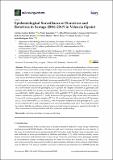Por favor, use este identificador para citar o enlazar a este item:
http://hdl.handle.net/10261/205605COMPARTIR / EXPORTAR:
 SHARE SHARE
 CORE
BASE CORE
BASE
|
|
| Visualizar otros formatos: MARC | Dublin Core | RDF | ORE | MODS | METS | DIDL | DATACITE | |

| Título: | Epidemiological Surveillance of Norovirus and Rotavirus in Sewage (2016–2017) in Valencia (Spain) |
Autor: | Santiso-Bellón, Cristina; Randazzo, Walter CSIC ORCID; Pérez-Cataluña, Alba CSIC ORCID; Vila-Vicent, Susana; Gozalbo-Rovira, Roberto CSIC ORCID ; Muñoz, Carlos CSIC ORCID; Buesa, Javier; Sánchez Moragas, Gloria CSIC ORCID; Rodríguez Díaz, Jesús CSIC ORCID | Palabras clave: | Rotavirus Norovirus Sewage Genotyping |
Fecha de publicación: | 2020 | Editor: | Multidisciplinary Digital Publishing Institute | Citación: | Microorganisms 8(3): 458 (2020) | Resumen: | The aim of the present study was to perform the molecular epidemiology of rotaviruses and noroviruses detected in sewage samples from a large wastewater facility from the city of Valencia, Spain. A total of 46 sewage samples were collected over a one-year period (September 2016 to September 2017). Norovirus and rotavirus were detected and quantified by RT-qPCR, genotyped by semi-nested RT-PCR and further characterized by sequencing and phylogenetic analyses. Noroviruses and rotaviruses were widely distributed in sewage samples (69.6% for norovirus GI, 76.0% norovirus GII, and 71.7% rotaviruses) and viral loads varied from 4.33 to 5.75 log PCRU/L for norovirus GI, 4.69 to 6.95 log PCRU/L for norovirus GII, and 4.08 to 6.92 log PCRU/L for rotavirus. Overall, 87.5% (28/32) of GI noroviruses could not be genotyped, 6.25% (2/32) of the samples contained GI.2 genotype, and another 6.25% (2/32) were positive for GI.4 genotype. The most common genotype of GII noroviruses was GII.2 (40%, 14/35), followed by GII.6 (8.6%, 3/35) and GII.17 (5.7%, 2/35) while the remaining GII strains could not be typed (45.7%, 16/35). Rotavirus VP4 genotype P[8] was the only one found in 19 out of 33 rotavirus-positive samples (57.7%). G2 was the most prevalent rotavirus VP7 genotype (15.2%, 5/33) followed by G3, G9, and G12, with two positive samples for each genotype (6.1%, 2/33). In one sample both G1 and G2 genotypes were detected simultaneously (3%). The results presented here show that the surveillance of noroviruses and rotaviruses in sewage is useful for the study of their transmission in the population and their molecular epidemiology. | Descripción: | © 2020 by the authors. | Versión del editor: | https://doi.org/10.3390/microorganisms8030458 | URI: | http://hdl.handle.net/10261/205605 | DOI: | 10.3390/microorganisms8030458 | E-ISSN: | 2076-2607 |
| Aparece en las colecciones: | (IATA) Artículos |
Ficheros en este ítem:
| Fichero | Descripción | Tamaño | Formato | |
|---|---|---|---|---|
| Epidemiological_Santiso_Art2020.pdf | 5,06 MB | Adobe PDF |  Visualizar/Abrir |
CORE Recommender
PubMed Central
Citations
21
checked on 19-abr-2024
SCOPUSTM
Citations
35
checked on 19-abr-2024
WEB OF SCIENCETM
Citations
29
checked on 25-feb-2024
Page view(s)
183
checked on 24-abr-2024
Download(s)
141
checked on 24-abr-2024
Google ScholarTM
Check
Altmetric
Altmetric
Artículos relacionados:
NOTA: Los ítems de Digital.CSIC están protegidos por copyright, con todos los derechos reservados, a menos que se indique lo contrario.
